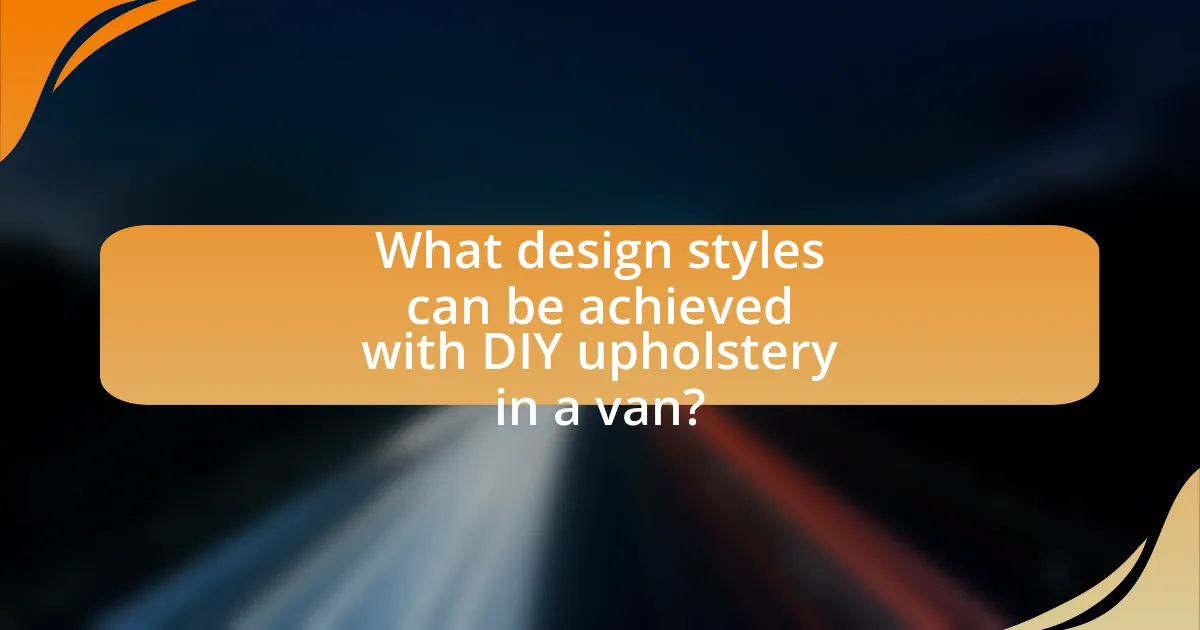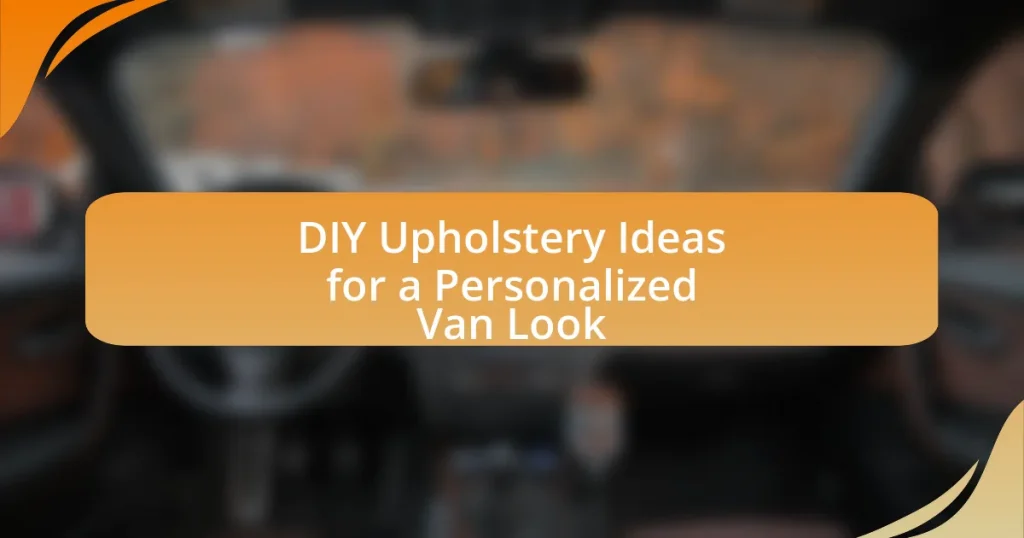DIY upholstery ideas for a personalized van look focus on enhancing the interior through reupholstering seats, adding custom cushions, and creating fabric wall panels. These techniques allow for the selection of unique fabrics and colors that reflect personal style while improving comfort and functionality. The article discusses the best materials for upholstery projects, popular techniques, and the cost benefits of DIY versus professional services. It also addresses common challenges, maintenance practices, and design styles, including bohemian, modern, and vintage aesthetics, providing a comprehensive guide for individuals looking to transform their van interiors.

What are DIY Upholstery Ideas for a Personalized Van Look?
DIY upholstery ideas for a personalized van look include reupholstering seats with unique fabrics, adding custom cushions, and creating fabric wall panels. Reupholstering seats allows for the selection of colors and patterns that reflect personal style, while custom cushions can enhance comfort and aesthetics. Fabric wall panels can transform the interior by introducing textures and designs that resonate with the owner’s taste. These methods not only improve the visual appeal but also increase the functionality of the van’s interior space.
How can DIY upholstery transform the interior of a van?
DIY upholstery can significantly enhance the interior of a van by allowing for personalized design and improved comfort. By reupholstering seats, curtains, and other surfaces, individuals can choose fabrics and colors that reflect their style, creating a unique atmosphere. This customization not only elevates the aesthetic appeal but also increases the functionality of the space, as specific materials can be selected for durability and ease of cleaning. Furthermore, studies show that personalized environments can positively impact mood and well-being, making a van feel more like home.
What materials are best for van upholstery projects?
The best materials for van upholstery projects include marine-grade vinyl, upholstery fabric, and foam padding. Marine-grade vinyl is durable, water-resistant, and easy to clean, making it ideal for the wear and tear of van life. Upholstery fabric, such as canvas or polyester blends, offers a variety of colors and patterns while providing comfort and style. Foam padding is essential for cushioning and support, with high-density foam being preferred for its longevity and comfort. These materials are commonly used in the industry due to their resilience and aesthetic appeal, ensuring a personalized and functional van interior.
How does upholstery impact the overall aesthetic of a van?
Upholstery significantly impacts the overall aesthetic of a van by influencing its visual appeal, comfort, and style. The choice of fabric, color, and pattern can transform a van’s interior, creating a cohesive look that reflects personal taste. For instance, using vibrant colors or unique patterns can make the space feel more inviting and lively, while neutral tones can create a calm and sophisticated atmosphere. Additionally, high-quality upholstery materials enhance the perceived value of the van, making it more attractive to potential buyers or users. Studies show that well-designed interiors can increase user satisfaction and comfort, which further emphasizes the importance of upholstery in achieving a desired aesthetic.
Why choose DIY upholstery over professional services?
Choosing DIY upholstery over professional services allows for greater customization and cost savings. DIY projects enable individuals to select fabrics, colors, and designs that reflect their personal style, which is particularly beneficial for creating a unique van interior. Additionally, undertaking upholstery work oneself can significantly reduce expenses; professional upholstery services often charge between $50 to $100 per hour, while DIY materials can be sourced for a fraction of that cost. This approach not only fosters creativity but also provides a sense of accomplishment upon completion.
What are the cost benefits of DIY upholstery?
DIY upholstery significantly reduces costs compared to hiring professional services, often saving 50% to 75% on labor expenses. By purchasing materials directly and utilizing personal labor, individuals can control expenses and select budget-friendly fabrics. For instance, a professional upholstery job may cost between $300 to $1,000, while DIY projects can be completed for as little as $100 to $500, depending on material choices. This cost-effectiveness allows for customization without the financial burden, making it an attractive option for those looking to personalize their van interiors.
How does DIY upholstery allow for personal expression?
DIY upholstery allows for personal expression by enabling individuals to choose fabrics, colors, and designs that reflect their unique tastes and preferences. This customization process transforms standard furniture or vehicle interiors into personalized statements, showcasing individual style. For instance, selecting a vibrant pattern or a specific texture can evoke emotions or memories, making the space feel more like home. Additionally, DIY upholstery projects often involve hands-on creativity, allowing individuals to engage in the design process actively, which further enhances their personal connection to the finished product.
What are some popular DIY upholstery techniques for vans?
Some popular DIY upholstery techniques for vans include reupholstering seats, adding custom cushions, and using fabric wraps. Reupholstering seats involves removing the old fabric and replacing it with new material, allowing for a fresh look and improved comfort. Adding custom cushions can enhance seating areas, providing both style and support, while fabric wraps can be applied to surfaces like walls and cabinets to create a cohesive design. These techniques are widely used by van owners to personalize their interiors and improve aesthetics.
How can reupholstering seats enhance comfort and style?
Reupholstering seats enhances comfort and style by replacing worn-out materials with high-quality fabrics and padding that provide better support and aesthetics. The process allows for customization, enabling individuals to select materials that match their personal taste and the overall design of the van. For instance, using memory foam can significantly improve seating comfort, while choosing vibrant or textured fabrics can elevate the visual appeal of the interior. Studies show that well-upholstered seats can reduce fatigue during long drives, making the experience more enjoyable.
What are the steps to create custom cushions for a van?
To create custom cushions for a van, follow these steps: First, measure the dimensions of the seating area to determine the size of the cushions needed. Next, select the foam type and thickness based on comfort preferences and intended use, ensuring it fits the measurements taken. After that, choose a durable fabric that complements the van’s interior and is suitable for upholstery. Cut the foam to size and shape, then cut the fabric, allowing extra material for seams. Assemble the cushion by wrapping the foam in the fabric, securing it with a staple gun or sewing it, depending on the chosen method. Finally, place the finished cushions in the van, ensuring they fit snugly and securely. These steps are validated by common upholstery practices, which emphasize accurate measurements, material selection, and proper assembly techniques for durability and comfort.
How can you ensure a successful DIY upholstery project?
To ensure a successful DIY upholstery project, start by selecting high-quality materials that are durable and suitable for the intended use. Using upholstery-grade fabric, which is designed to withstand wear and tear, significantly increases the longevity of the project. Additionally, proper preparation is crucial; this includes measuring the furniture accurately, removing old upholstery carefully, and ensuring the frame is in good condition. Following a step-by-step guide or tutorial can also enhance the outcome, as it provides structured instructions and techniques specific to upholstery. Research shows that projects completed with a clear plan and quality materials have a higher success rate, as evidenced by numerous DIY forums and upholstery workshops where participants report satisfaction with their finished products.
What tools and supplies are essential for upholstery projects?
Essential tools and supplies for upholstery projects include a staple gun, upholstery fabric, foam padding, scissors, and a sewing machine. The staple gun is crucial for attaching fabric to furniture frames securely, while upholstery fabric provides the necessary aesthetic and durability for the project. Foam padding is essential for comfort and shape, and sharp scissors are needed for precise cutting of materials. A sewing machine facilitates the stitching of fabric pieces together, ensuring a professional finish. These tools and supplies are fundamental for achieving quality results in upholstery work.
How do you prepare a van for upholstery work?
To prepare a van for upholstery work, first, remove all existing upholstery and components that may obstruct the process, such as seats, panels, and flooring. This step is crucial as it provides a clean workspace and allows for thorough inspection of the underlying surfaces. Next, clean the surfaces thoroughly to eliminate dirt, dust, and grease, ensuring proper adhesion of new materials. Additionally, assess the condition of the van’s interior structure, making necessary repairs to any damaged areas before proceeding with the upholstery. This preparation is essential for achieving a professional finish and longevity of the new upholstery.

What design styles can be achieved with DIY upholstery in a van?
DIY upholstery in a van can achieve various design styles, including bohemian, minimalist, vintage, and modern. Each style can be realized through specific fabric choices, color palettes, and patterns. For instance, bohemian style often incorporates vibrant colors and eclectic patterns, while minimalist design favors neutral tones and simple lines. Vintage aesthetics can be achieved with retro fabrics and classic patterns, whereas modern styles typically utilize sleek, contemporary materials. The versatility of DIY upholstery allows for a personalized touch that reflects individual preferences and enhances the overall ambiance of the van.
How can you incorporate bohemian elements into van upholstery?
To incorporate bohemian elements into van upholstery, use vibrant fabrics with intricate patterns, such as paisley or floral designs, and mix textures like macramé or crochet. These choices reflect the bohemian aesthetic, which emphasizes individuality and artistic expression. Additionally, integrating earthy tones and natural materials, such as cotton or linen, enhances the organic feel typical of bohemian style. Using layered textiles, such as throw pillows and blankets in various colors and patterns, can create a cozy, eclectic atmosphere that embodies the bohemian spirit.
What fabrics work best for a bohemian van look?
Natural fabrics such as cotton, linen, and hemp work best for a bohemian van look. These materials are breathable, durable, and often feature vibrant patterns or textures that align with the bohemian aesthetic. Cotton is widely used for its softness and versatility, while linen offers a more textured appearance that enhances the relaxed vibe. Hemp is eco-friendly and adds a rustic touch, making it ideal for a personalized van interior. The combination of these fabrics creates a cozy, inviting atmosphere that embodies the essence of bohemian style.
How can patterns and colors enhance a bohemian theme?
Patterns and colors enhance a bohemian theme by creating a vibrant and eclectic atmosphere that reflects individuality and creativity. The use of intricate patterns, such as paisleys, florals, and geometric designs, adds visual interest and depth, while a rich color palette featuring earthy tones, jewel tones, and bold contrasts evokes a sense of warmth and comfort. This combination not only embodies the free-spirited essence of bohemian style but also allows for personal expression, making spaces feel unique and inviting. Studies in design psychology indicate that color can influence mood and perception, supporting the idea that a well-curated mix of patterns and colors can significantly enhance the overall aesthetic and emotional impact of a bohemian-themed environment.
What modern design trends can be applied to van upholstery?
Modern design trends that can be applied to van upholstery include minimalism, sustainable materials, and bold patterns. Minimalism emphasizes clean lines and a clutter-free aesthetic, which can create a spacious feel in a van. Sustainable materials, such as recycled fabrics and eco-friendly textiles, are increasingly popular, reflecting a growing awareness of environmental impact. Bold patterns, including geometric designs and vibrant colors, can add personality and visual interest to the van’s interior. These trends align with contemporary preferences for both functionality and style in mobile living spaces.
How does minimalism influence upholstery choices for vans?
Minimalism influences upholstery choices for vans by prioritizing simplicity, functionality, and a clean aesthetic. This approach leads to the selection of materials that are durable yet understated, such as neutral fabrics and streamlined designs that avoid excessive patterns or embellishments. Minimalist upholstery often incorporates multifunctional elements, like convertible seating or storage solutions, which maximize space efficiency while maintaining a visually uncluttered environment. The emphasis on fewer, high-quality pieces rather than numerous decorative items aligns with minimalist principles, promoting a serene and organized living space within the van.
What are the key features of a modern van upholstery design?
Key features of modern van upholstery design include functionality, durability, and aesthetic appeal. Functionality is achieved through modular designs that allow for easy customization and reconfiguration of seating and storage. Durability is emphasized by using high-quality, weather-resistant materials that withstand wear and tear, such as marine-grade fabrics and synthetic leathers. Aesthetic appeal is enhanced through contemporary color palettes, patterns, and textures that reflect personal style while maintaining a cohesive look. These features collectively contribute to a comfortable and visually pleasing van interior, catering to the needs of modern travelers.
How can vintage styles be integrated into van upholstery?
Vintage styles can be integrated into van upholstery by using retro fabrics, patterns, and colors that evoke a specific era, such as the 1960s or 1970s. Selecting materials like floral prints, bold geometric designs, or classic plaid can create an authentic vintage feel. Additionally, incorporating elements like tufted cushions, leatherette, or vinyl can enhance the retro aesthetic. Historical trends show that these styles were popular in vintage camper vans, making them a fitting choice for modern DIY projects. Using these specific design elements not only personalizes the van but also pays homage to the rich history of automotive design.
What vintage fabrics are suitable for van upholstery projects?
Cotton canvas, denim, and upholstery-grade velvet are suitable vintage fabrics for van upholstery projects. Cotton canvas is durable and easy to clean, making it ideal for high-traffic areas. Denim offers a rugged aesthetic and is also resilient, while upholstery-grade velvet adds a touch of luxury and comfort. These fabrics have been historically used in various upholstery applications due to their strength and versatility, ensuring they can withstand the wear and tear associated with van interiors.
How can you achieve a retro look with upholstery techniques?
To achieve a retro look with upholstery techniques, select vintage fabrics such as bold patterns, florals, or geometric designs that were popular in the mid-20th century. Incorporating these fabrics into your upholstery will evoke the desired nostalgic aesthetic. Additionally, using techniques like tufting or piping can enhance the retro feel, as these were commonly used in vintage furniture. For instance, tufted cushions with contrasting piping can create a classic look reminiscent of the 1960s and 1970s.

What are some common challenges in DIY van upholstery?
Common challenges in DIY van upholstery include selecting appropriate materials, achieving a professional finish, and managing limited space. Selecting materials can be difficult due to the need for durability and aesthetic appeal, as van upholstery must withstand wear and tear while also fitting the desired style. Achieving a professional finish often requires advanced sewing skills and tools, which many DIYers may lack. Additionally, managing limited space in a van can complicate the upholstery process, making it challenging to maneuver large pieces of fabric and equipment. These challenges are frequently cited by DIY enthusiasts in forums and guides, highlighting the complexities involved in transforming a van’s interior effectively.
What mistakes should be avoided during upholstery projects?
During upholstery projects, it is crucial to avoid common mistakes such as inadequate measurements, poor fabric selection, and neglecting to prepare the surface properly. Inadequate measurements can lead to fabric shortages or excess, resulting in wasted materials and time. Poor fabric selection, including choosing materials that are not durable or suitable for the intended use, can compromise the quality and longevity of the upholstery. Additionally, neglecting to prepare the surface, such as failing to clean or repair the underlying structure, can lead to unsatisfactory results and potential damage over time. These mistakes can significantly impact the overall success of the upholstery project.
How can improper measurements affect the outcome of upholstery?
Improper measurements can lead to ill-fitting upholstery, resulting in a visually unappealing and uncomfortable finish. When dimensions are inaccurate, the fabric may be too loose or too tight, causing wrinkles, bunching, or difficulty in installation. For instance, a study by the Furniture Society highlights that precise measurements are crucial for achieving a professional look in upholstery projects. Additionally, incorrect measurements can lead to wasted materials and increased costs, as excess fabric may need to be purchased or adjustments made to rectify the errors.
What are the risks of using low-quality materials?
Using low-quality materials in DIY upholstery poses several risks, including reduced durability, safety hazards, and compromised aesthetics. Low-quality fabrics and foams may wear out quickly, leading to frequent replacements and increased long-term costs. Additionally, inferior materials can lack fire resistance, posing safety risks in case of an accident. Furthermore, low-quality upholstery may not adhere well, resulting in an unprofessional appearance that detracts from the overall look of the van. These factors highlight the importance of selecting high-quality materials for successful and safe upholstery projects.
How can you troubleshoot common upholstery issues?
To troubleshoot common upholstery issues, first identify the specific problem, such as fabric tears, stains, or sagging. For fabric tears, use a fabric adhesive or patch to secure the area; this method is effective as it restores the integrity of the material. For stains, apply a suitable cleaner based on the fabric type, ensuring to test in an inconspicuous area first to avoid damage. Sagging can often be addressed by tightening the upholstery or replacing the underlying padding, which is crucial for maintaining comfort and appearance. These methods are supported by upholstery repair guidelines that emphasize the importance of addressing issues promptly to prolong the life of the upholstery.
What should you do if upholstery fabric is wrinkled or sagging?
To address wrinkled or sagging upholstery fabric, steam the fabric using a handheld steamer or an iron on a low setting with a cloth barrier. This method relaxes the fibers, allowing them to regain their shape. Additionally, for sagging fabric, check the underlying support structure; tightening or replacing the padding can restore firmness. Regular maintenance, such as fluffing cushions and ensuring proper tension, can prevent future issues.
How can you fix seams that are coming apart?
To fix seams that are coming apart, you should use a sewing machine or needle and thread to re-stitch the seam. First, ensure the fabric is clean and lay it flat. Then, align the edges of the seam and sew along the original stitching line or slightly inside it for added strength. This method is effective because re-stitching reinforces the fabric and prevents further unraveling. Additionally, using a strong thread, such as polyester, can enhance durability, as polyester is known for its resistance to wear and tear.
What are the best practices for maintaining DIY upholstery in a van?
The best practices for maintaining DIY upholstery in a van include regular cleaning, using protective treatments, and ensuring proper ventilation. Regular cleaning prevents dirt and stains from setting in, which can damage the fabric over time. Using protective treatments, such as fabric protectors, can help repel spills and stains, extending the life of the upholstery. Proper ventilation reduces moisture buildup, which can lead to mold and mildew, further preserving the integrity of the materials used. These practices are essential for maintaining the aesthetic and functional quality of DIY upholstery in a van.
How can regular cleaning extend the life of upholstery?
Regular cleaning can significantly extend the life of upholstery by removing dirt, dust, and allergens that can degrade fabric fibers over time. When upholstery is cleaned regularly, it prevents the buildup of grime that can lead to stains and deterioration, thereby maintaining the material’s integrity and appearance. Studies indicate that regular maintenance can increase the lifespan of upholstery by up to 50%, as it reduces wear and tear caused by accumulated debris.
What protective treatments can be applied to upholstery fabrics?
Protective treatments that can be applied to upholstery fabrics include stain repellents, water repellents, and UV protectants. Stain repellents create a barrier that prevents liquids and dirt from penetrating the fabric, making it easier to clean and maintain. Water repellents, such as silicone-based sprays, help to keep upholstery dry and prevent mold and mildew growth. UV protectants shield fabrics from sun damage, reducing fading and deterioration over time. These treatments enhance the longevity and appearance of upholstery, making them essential for maintaining a personalized van look.



